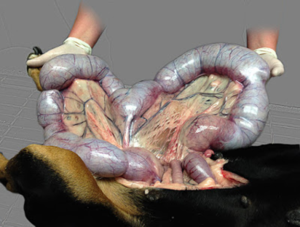PYOMETRA
Pyometra is a very serious condition that affects female dogs who have not been spayed. This condition occurs when large amounts of fluid start to accumulate in the female dog’s uterus (it is more often seen in dogs that have recently been on heat).
The condition develops when infection gains entry into the bitch’s uterus, such as when the female dog’s cervix has relaxed when she is on heat (oestrus). As the infection takes hold pus will start to accumulate inside the uterus causing it to swell and become inflamed (in fact it can become so large that it becomes the same size that is seen in a pregnant dog). As the infection progresses the toxins from the accumulated pus will start to infect the blood stream causing the female dog to be slowly poisoned.
There are two forms of this condition, one is referred to as closed-cervix pyometra and the other is not surprisingly known as open-cervix pyometra. Both types are serious but one is often less dangerous than the other. In the closed-cervix variety there will be a large amount of reddish pus that is released by the relaxed cervix – this is not as dangerous as the open-cervix form which causes the uterus to swell (due to the pus not being drained). Open-cervix pyometra will cause pain in the abdomen, sickness and vomiting, fast pulse rate and even shock (this is due to the build-up of toxins).
Symptoms Of Pyometra In Dogs
- Excessive drinking.
- The affected dog may start to urinate more frequently.
3 The abdomen may become distended.
- Sickness and vomiting.
- Shock.
- High temperature.
- In the open-cervix form the vulva may release a really nasty smelling red/brown discharge.
- An affected dog may also appear depressed.
- An affected dog may also develop a rapid pulse.
Ultrasonography may be performed on the affected dog as this helps to distinguish whether the uterus is enlarged due to pregnancy or due to pyometra. As the condition is normally an emergency situation the vet needs to be involved as soon as possible following discover of a pyometra. It IS life-threatening.
Treating Pyometra In Dogs
Treatment for the condition should happen as a matter of urgency as the affected female can quickly develop shock and death is a real possibility. The most common treatment is where the vet will perform an Ovariohysterectomy – this is where the vet will remove the dog’s reproductive organs including the ovaries, the uterus and the uterine horns. Alongside this surgery the vet will also prescribe antibiotics.
There is an alternative to an Ovariohysterectomy and this is where Prostaglandin is prescribed – this helps the cervix to relax leading to uterine contractions then enabling any pus to be discharged. If the pus is not discharged then a new course of injections (of Prostaglandin) will be administered.
